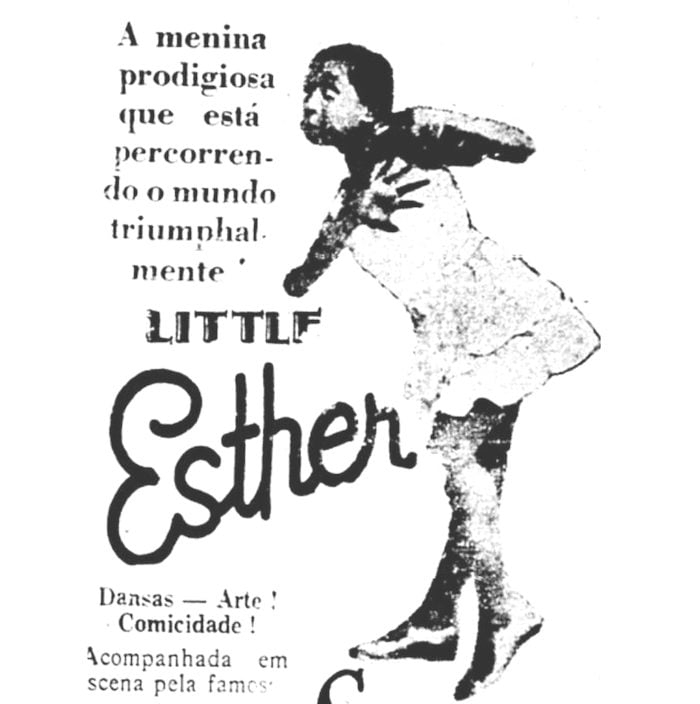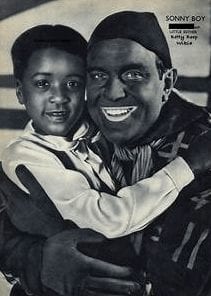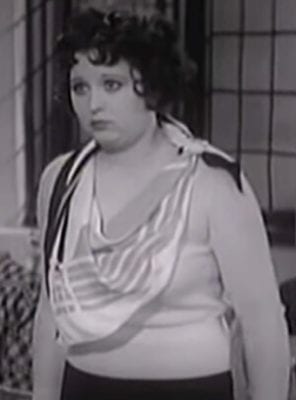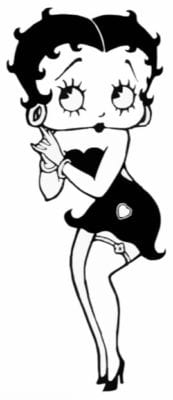Esther Jones: Betty Boop’s Original Influence

A 1931 poster highlighting Esther Jones and her upcoming performances at the El Dorado theater in Brazil. (Source)
May 24, 2021 ~ By Shari Rose
Updated November 21, 2021
Esther Jones, Original Boop-Oop-A-Doop Scatting Icon from the 1920s
“Baby Esther” Jones was an international star from Chicago known for captivating audiences with her signature “boop-oop-a-doop” singing style. But as a Black child in Jim Crow-era America, Jones’ legacy was quickly forced into obscurity, lost to a white singer who copied her performing style, claimed it as her own, and sued over the creation of a famous cartoon character that followed soon after. This is the story of Betty Boop’s original influence, and star in her own right, the incredible Esther Jones.
Esther Jones’ Early Career
Esther Lee Jones was born in Chicago somewhere between 1918 and 1921 to Gertrude and William Jones. From an early age, Esther showed a natural talent for performing. Her parents encouraged and involved Esther in singing and dancing competitions as a small child. When she was around 5 years old, she competed in a Charleston dance competition in Chicago. Esther won first prize and attracted the attention of a white talent manager named Lou Bolton.

Esther Jones appears in a minstrel show with a white performer in blackface in 1929. (Source)
After the win, Bolton offered to represent Jones as her talent agent, and her parents agreed. Esther Jones began performing in mostly whites-only clubs throughout Chicago, New York, and other major cities in the Northeast. Jones became a big hit with white audiences, who were enraptured by her childlike charm and impressive singing ability. She danced and sang songs, occasionally performing in racist minstrel shows alongside white men in blackface to the delight of crowds.
In most venues that Jones attended, Black people were not allowed to enter the buildings unless they were there to entertain. In the years that Esther Jones was active in show business, Jim Crow laws infiltrated all parts of American society. The KKK experienced a resurgence in national membership and an outpouring of support from elected officials. Mob lynchings continued to terrorize people of color and the justice system sought to serve whites at the expense of Black lives.
This was the deeply racist society that a young Black performer like Esther Jones had to work with. And she was a massive hit with white audiences. Her effortless charm and consistent big smile entertained audiences who could treat her like a delightful novelty that presented no threat to the white supremacist society they benefitted from.
Esther Jones’ “Boop-Oop-A-Doop” Singing Style
At an early point in her career, child star Esther Jones introduced a “boop-oop-a-doop” singing style into her performances. This baby-voice scatting style dazzled Jazz Age audiences and gained Jones critical acclaim virtually wherever she performed. Jones is believed to be the first singer to incorporate boop-oop-a-doop scatting, though that notion is fraught with a controversial history.
Jones was known by many stage names before she gained her famous “Baby Esther” moniker. She was called “Little Esther”, “Farina’s Kid Sister,” and “Miniature Florence Mills,” which referenced other Black performers of the era. With her parents and manager in tow, Esther Jones continued to travel and perform in major cities in the U.S., attracting a growing number of fans wherever she went. At the time, Baltimore newspaper The Afro-American reported that Jones was believed to be “the highest paid child artist in the world.”
Helen Kane Swipes Jones’ Scatting Style

Helen Kane in a 1931 comedy called “A Lesson in Love.” (Source)
One New York venue that Esther Jones regularly performed in was the Cotton Club in Harlem. Like most clubs that Jones attended, the Cotton Club did not allow Black audience members. One night in 1928, a white singer named Helen Kane sat in the front row and watched Esther Jones sing and dance with her signature boop-oop-a-doop scatting.
Kane was a former vaudeville performer and currently active in New York City musicals when she first saw Esther Jones on stage. Kane then directly copied Jones’ boop-oop-a-doop singing into her own acts, and claimed the style as her own.
Later that same year, Kane released “I Wanna Be Loved by You,” which was her first song that incorporated Jones’ boop-oop-a-doop singing style. Kane reached immediate commercial success with this hit, and her national profile as a Jazz Age singer soared. She continued to take advantage of the style, and incorporated it into all of her future performances.
Kane never publicly acknowledged Esther Jones as the originator of the boop-oop-a-doop scatting, the reason for Kane’s breakthrough. Kane even went so far as to argue in court that she had created that scatting all by herself.
Esther Jones Goes on European Tour
In 1929, Esther Jones traveled to Europe with her manager and parents, touring in France, Spain, Sweden, Germany, and other countries. Her first European performance took place at the Moulin Rouge in Paris, where she received universal acclaim. She was covered extensively in major magazines and newspapers throughout Europe, and even gave private shows to royal members of society including the kings and queens of both Spain and Sweden.
Away from the systemic racism that permeated every part of her life in her home country, Esther Jones was generally held in high regard and welcomed with open arms in Europe. But her tour wasn’t without its obstacles. In one such case, Jones and her parents visited a restaurant in Stockholm, Sweden that was run by an American immigrant. The restaurant owner refused to serve the Joneses because they were Black, and the family was forced to leave.
When this incident was reported in local newspapers, Swedish officials and private citizens alike condemned the racist act and offered public support for Esther Jones. In the public outcry that followed, the American restaurant was forced to close as Swedes condemned the owner’s unconscionable display of racism.
More stories: How African Slaves Hid Rice Seeds In Their Hair & Transformed the Colonial Economy
More stories: The Triumphs of Edward Gardner at the 1928 Bunion Derby
Helen Kane Sues Over Betty Boop Cartoon

Betty Boop cartoon character created by Max Fleischer. (Source)
In 1930, the iconic character Betty Boop first appeared in a cartoon called Dizzy Dishes. Boop was created by cartoonist Max Fleischer under Paramount Publix Corporation. Just like Esther Jones, Boop became an instant hit with audiences. Betty Boop remains famous today for her baby-like singing voice, boop-oop-a-doop scatting, and often over-sexualized style.
Helen Kane, who had reached national success as a direct result of using Jones’ boop-oop-a-doop scatting into her own performances, sued both Max Fleischer and Paramount Publix Corporation in 1932. She contended they had stolen her image and style with the Betty Boop cartoon (while failing to admit that she originally stole that singing style from “Baby Esther” Jones).
The lawsuit dragged on for two years until a 1928 film reel was brought into court. It showed Esther Jones performing her trademark boop-oop-a-doop on stage months before Kane’s hit single was released. Helen Kane lost the suit on May 5, 1934.
Despite being the reason that Kane’s case was dismissed, Esther Jones was never called to testify. The teenage star had returned to America after doing a tour in South America and was performing in the states at the time of the lawsuit. Though Paramount admitted that Betty Boop’s singing style was based on Baby Esther, the studio never offered her a cent for using her likeness and image in creating the widely successful cartoon. The studio argued in court it did not owe compensation to Jones because she had disappeared from the public spotlight and was presumed dead.
Esther Jones was very much alive and still active in show business at the time. Paramount simply refused to give money to a Black performer they owed in part for their rampant successes.
Share Esther’s story
 |
 |
 |
 |
 |
 |
“Baby Esther” Jones Leaves Show Business
Two months after Kane’s lawsuit ended, Jones gave her final performance at a NAACP event in Philadelphia. She left the limelight before becoming a legal adult. And unfortunately, that is all the information we have about Baby Esther. True to the era, all we know about Esther Jones’ life is its relationship to entertaining white people.
The cultural contributions and achievements of people of color, especially Black women, are erased so efficiently in America. “Baby Esther” Jones was an international child star, and her memory was erased so quickly in American public consciousness because she was Black.
Black excellence is a direct contradiction to white supremacy. And like so many who came before and after her, Esther Jones’ legacy was whitewashed and stolen to retroactively protect white supremacist beliefs that are as old as the country itself.
Despite the outcome of the lawsuit proving otherwise, Helen Kane was still widely regarded as the core inspiration for Betty Boop and the boop-oop-a-doop singing style for more than 90 years. Let us do what we can to ensure that “Baby Esther” Jones is rightly credited for her incredible achievements and influence on American popular culture for the next 90.







This article contains multiple errors.
First, the photo at the top is NOT Esther Jones.
Next, Esther performed as Little Esther, not Baby Esther.
Third, Esther never performed at the Cotton Club.
Fourth, it was falsely claimed by one man, Lou Bolton(Esther’s manager) that Helen Kane had seen Esther perform at the Everglades(not the Cotton Club). However, when questioned about that claim, Bolton’s story crumbled and he had to admit that that was NEVER TRUE.
Fifth..there is NOTHING AT ALL to support that Esther originated Boop boop a doop, or had ever used it prior to Kane. Only the word of Bolton. A man who it was demonstrated had LIED UNDER OATH. So, why believe him saying Esther had originated Boop boop a doop?
Sixth, Kane had been scatting years BEFORE allegedly seeing Esther.
Seventh, Kane never claimed to have invented scatting. She only said she was the first to use the phrase Boop boop a doop.
Eighth, the trial didn’t “drag on for two years”. The entire trial lasted less than two months.
Ninth, the film of Esther was recorded significantly AFTER Kane started Boop boop a doop. In the film Esther sings three HELEN KANE SONGS. It is a film of Esther imitating Helen Kane.
Tenth, Esther was never mentioned in the judge’s verdict. Esther was NOT “the reason Kane’s case was dismissed”. The actual trial transcripts are available. They are totally different to what you say here.
So, this article is just a totally unfounded accusation of plagiarism and theft against Helen Kane . It repeats disgusting claims that have been refuted years ago.
Far from “empowering”, all it is is a smear job on a woman who isn’t alive to defend herself.
This article doesn’t demonstrate that Esther Jones was the original. It doesn’t even use a photograph of the real Esther Jones. And anyone who looks up the actual trial transcripts will learn the real truth.
All this is is an attack on Helen Kane, accusing a dead woman of committing wrongs that she never did.
Hi John,
Please send me legitimate sources for your assertions and I’m happy to make edits if they back up your claims. The sources linked throughout the piece prove otherwise, but give me something interesting to read and I’ll check it out
@Shari Rose
This is a really good article.
The photo is not Esther Jones in the top photo but the one with the little girl and the man in Blackface is.
It’s not a good idea to listen to the this “John Miller” he is telling lies. There is a racist group of people going around trying to discredit how Helen Kane coined “boop-boop-a-doop” from a latter of African-American performers from the early 1920s.
He won’t be able to find any legit sources. Also Esther’s manager Louis Bolton did not say or admit that he lied under oath. That is another made-up story. That never happened in the lawsuit documents. He was more or less exposed for being paid by Paramount and the Fleischers to testify for a quick pay check.
But he was not lying about the whole scatting origination. If anyone has done research you will know that Esther was a Florence Mills impersonator. And her style was based on Mills. When Helen Kane saw Esther on stage, she imitated Esther’s “Florence Mills” impersonation.
Esther started scatting in 1925, long before Kane was known. When they shared the same manager in 1928, Helen saw Esther’s performance on the stage and copied her act.
Esther was using the “boop-boop-a-doop” phrase after Helen Kane in a MGM short, but Helen had saw her earlier that year, and had copied Esther’s act but she changed the scat sounds.
As you can see he wrote “all this is is an attack on Helen Kane, accusing a dead woman of committing wrongs that she never did.” Which is something she did do. She was caught and people like this man don’t like the truth being shared, so they go from page to page under false identities and personas making false claims to try and change what actually happened.
It was proved in court that Helen Kane was a copy-cat and was not original. So these people have some kind of agenda but most of us are not falling for it.
When someone “in-directly” takes something and slightly alters it, there is no way that you would be able to prove that they have stolen from you. Regardless of Esther scatting from 1925, and Helen Kane being influenced by her, Esther never once laid claim to Helen Kane’s title. But it still doesn’t hide the fact that Helen Kane coined Esther’s routine and changed the words.
In court it was also proven that Helen Kane did not originate the baby-singing style. Nothing about her was original.
Thanks for sharing this article. It was wonderful to read. You may want to remove the photograph of Esther Bigeou up the top, that is another performer.
Hi Violet,
Thank you for letting me know about the featured image up top – I’ve switched it out. And to your point, the level of misinformation and outrage and vitriol I’ve encountered since publishing this piece has been eye-opening. The story of Esther Jones as well as Helen Kane’s attempt to claim false ownership of Jones’ style and greater legacy is an all-too-common example of the ongoing endeavor of many to disparage and erase the accomplishments and contributions of people of color throughout American history. It happened 200+ years ago, it continues to happen in 2021. But, that’s why it’s so important to set the record straight when we can, and push back against people like John whose interests are not in telling the truth, but rather crafting a bogus narrative about this country’s history that makes them feel more comfortable.
Violet, thank you so much for reaching out.